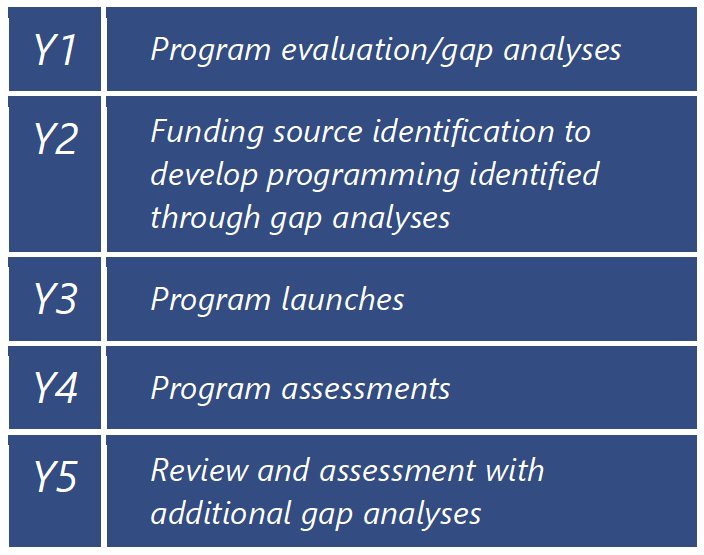MEASURING SUCCESS
IMPLEMENTATION & EVALUATION FRAMEWORK
IMPLEMENTATION
seCTer has been operating as a functioning economic development organization since 1993, with an active Economic Development Committee deeply involved in the creation of CEDS 2023. seCTer staff will, jointly with support from the Economic Development Committee, facilitate meetings, workshops and networking events aimed at engaging individuals and organizations in CEDS 2023 5-year implementation process illustrated below.

EVALUATION FRAMEWORK
Perhaps one of the most important mechanisms needed to implement this plan is coordinated collaboration. seCTer envisions that a key role of the Economic Development Committee, jointly with dedicated support from seCTer staff, is to facilitate meetings, workshops and networking events aimed at engaging individuals and organizations in the implementation process.
While a list of regional priority projects is NOT the focus of CEDS 2023 or the planning process, the importance of adopting a project prioritization process remains. CEDS 2017 provided the region with several goals, objectives and actions. However, seCTer staff and leading stakeholders indicated it was an onerous and challenging task to track progress and outcomes.

seCTer will annually solicit projects throughout the region using a data collection tool. Tracking the status of each project is not the objective for seCTer; establishing the list is in order to a develop a regional listing of priority projects. Each project will be associated with one of the three main goals. Prioritization will identify projects vital to the region, aligned with CEDS 2023, and ready for potential funding.
Throughout this planning process, seCTer has been provided adaptive and resilient project prioritization tools including but not limited to:
- Stoplight System. Identify projects and initiatives that are complete or nearly complete, irrelevant due to new conditions, or have an outcome that is too abstract to report. Categorize actions and projects into red (remove), yellow ( keep in the pipeline), and green (prioritize the “low-hanging fruit” and clear priorities in the current environment).
- Leading Practices. Utilize an assessment of projects and initiatives that is consistent with leading practices across the nation but customized to Southeastern Connecticut.
- Project Prioritization Rubric. Assess remaining projects and initiatives in a rubric with a ranking of Urgent to Not Urgent on one axis and Important to Not Important on another. The rubric will further break down projects into:
-
Top Priority Vital projects with substantial urgency
-
Significant Pipeline Critical projects with minimal urgency
-
Delay/Delegate Pressing projects with negligible impact
-
Insignificant/Remove Minor projects with little urgency
-
-
seCTer Values. Review project/program against seCTer’s official mission statement, vision statement and values. If a project or program does not align with those, remove it.
Using subscription-based data tools, seCTer will monitor household median income in the region, cost of housing as a percentage of income, available housing units, business starts and closings, and Regional Gross Domestic Product.
